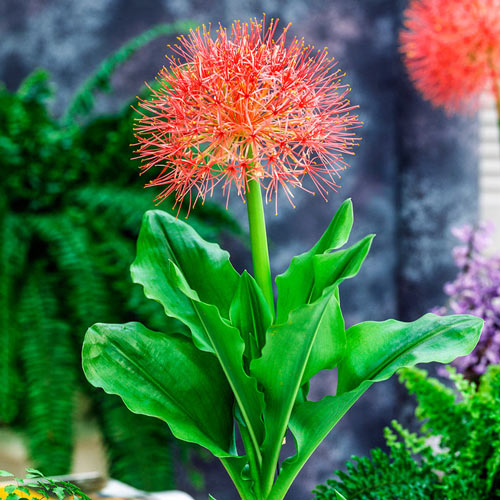The Blood Lily is a beautiful flower that blooms in the summer. They are native to South Africa and bloom from June to August. The flowers are red and have a black center.
The petals are thin and fragile.
If you’re looking for a splash of color in your garden, blood lilies are a great option. These flowers bloom in shades of red, orange, and yellow, and they’re sure to add some drama to your landscape. But when do blood lilies bloom?
In general, blood lilies bloom in late spring or early summer. However, the exact timing can vary depending on the variety of flower and your location. For example, some varieties may start blooming in May while others won’t start until June or July.
To ensure that your blood lilies bloom when you want them to, it’s best to plant them in advance. This way, you can control the conditions they’re growing in and give them a head start on the blooming process. Once they’re planted, all you need to do is wait patiently for those beautiful blooms to appear!

Credit: www.michiganbulb.com
Do Blood Lilies Bloom More Than Once?
Yes, blood lilies bloom more than once. In fact, they are known to re-bloom multiple times throughout the growing season. This is one of the reasons why they are such popular garden plants.
What Month Do Lily Flowers Bloom?
Lily flowers typically bloom in the summer months, with June and July being the peak months. However, depending on the type of lily and the climate they are growing in, they can bloom as early as May or as late as August.
What Month Do Lilies Sprout?
Lilies are a type of flowering plant that belongs to the genus Lilium. There are many different species of lilies, and they can be found in a wide range of colors including white, yellow, orange, pink, and red. Lilies typically bloom in the summer months, but the exact time will depend on the particular species.
For example, tiger lilies typically bloom in July, while Asiatic lilies usually bloom in June.
If you’re thinking about planting lilies in your garden, it’s important to know that they need full sun and well-drained soil in order to thrive. Once you’ve got those two things taken care of, you can then choose the specific type of lily that you want to grow.
If you’re not sure when to plant them, most varieties should be planted in the spring so that they have plenty of time to establish themselves before blooming season arrives.
How Long Do Blood Lilies Last?
The blood lily (Scadoxus multiflorus) is a bulbsous plant that is native to Africa. It gets its name from the deep red color of its flowers, which bloom in summer and last for about a week. The plant is not frost-tolerant and should be planted in well-drained soil in a sunny spot.
Blood lily in bloom haemanthus multiflorus
Blood Lily Symbolism
The Blood Lily is a flower that is found in tropical areas. The meaning of the Blood Lily can vary depending on the culture. In some cultures, the Blood Lily is seen as a symbol of purity and innocence.
In other cultures, the Blood Lily is seen as a symbol of death and rebirth.
No matter what the meaning of the Blood Lily is in your culture, there is no denying that this flower is beautiful. The deep red color of the petals are stunning against the green leaves.
If you are looking for a flower to add to your garden, consider adding a Blood Lily.
Blood Lily Growing Conditions
The Blood Lily is a beautiful flower that blooms in the summer. They are native to South Africa and require specific growing conditions in order to thrive.
Blood Lilies need full sun and well-drained soil.
They prefer warmer temperatures and will not tolerate frost. If you live in an area with cooler winters, you can grow Blood Lilies in containers and bring them indoors when the temperature starts to drop.
When watering your Blood Lilies, be sure to keep the leaves dry.
too much moisture can lead to fungal diseases. These flowers are also relatively drought tolerant, so don’t worry if you forget to water them occasionally. Just make sure to give them a good drink when they start to look wilted.
Fertilizing your Blood Lilies is important for keeping them healthy and vigorous. Use a balanced fertilizer that is low in nitrogen and high in phosphorus. Apply it monthly during the growing season (spring through summer).
You can reduce the frequency of fertilization once the plants start to bloom.
If you follow these tips, you should have no problem growing healthy and beautiful Blood Lilies!
Is Blood Lily Poisonous
Most people think of lilies as being beautiful, fragrant flowers. However, blood lilies are a type of lily that is actually poisonous. The blood lily is native to Africa and its scientific name is Scadoxus multiflorus.
The blood lily gets its name from the deep red color of its flowers. Blood lilies are also known as poison bulbs or African magic lilies.
The blood lily contains poisonous alkaloids that can be harmful to humans and animals if ingested.
Symptoms of poisoning include vomiting, diarrhea, abdominal pain, and convulsions. In severe cases, it can lead to coma or death. If you suspect that someone has ingested a blood lily, it is important to seek medical attention immediately.
While the blood lily is considered to be poisonous, it is still used in some traditional African medicine practices. The poison is extracted from the plant and used in very small doses to treat conditions such as epilepsy and snake bites. As with any medicinal plant, it is important to consult with a qualified healthcare practitioner before using any part of the plant for treatment purposes.
Are Ox Blood Lillies and Blood Lillies the Same Thing?
Are Ox Blood Lillies and Blood Lillies the same thing? Both terms refer to the magnificent flowering plant known for its vibrant crimson hue. The ox blood lily blooming season is a captivating time when these captivating flowers grace gardens and landscapes. Whether referred to as Ox Blood Lillies or simply Blood Lillies, they are synonymous with their striking beauty during the blooming season.
Blood Lily Indoor
The Blood Lily is a beautiful indoor plant that gets its name from its deep red flowers. The Blood Lily is native to South Africa and is related to the amaryllis. The Blood Lily is a perennial plant, meaning it will come back year after year.
The Blood Lily grows from a bulb and can reach up to 3 feet tall. The deep red flowers of the Blood Lily are very fragrant and bloom in the summertime.
Conclusion
The blooming of blood lilies is a sign of the end of summer. These beautiful flowers only bloom for a few days, and then they die.






